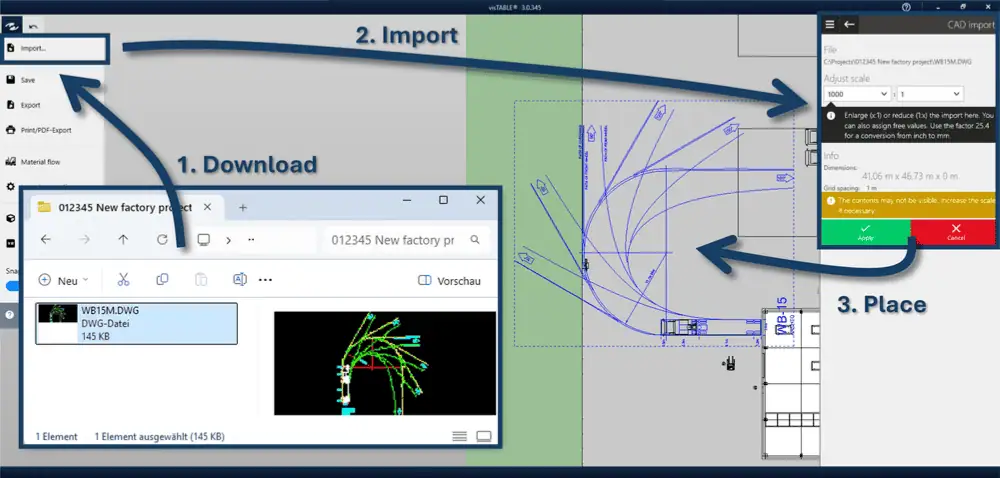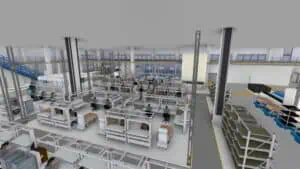simplifying the planning of traffic spaces
The following questions arise at some point during almost every factory planning project. But they are often left unanswered until it is much too late, and even then, many of the answers are based on “gut feeling” alone – with expensive consequences: unnecessary replanning, maneuvering problems or even safety risks.
How much space will trucks need to negotiate the corners?
Will forklifts have problems using the new hall entrance?
Is the available turning radius in the picking area sufficient?
The good news: Swept path analysis helps you to identify potential tight spots at an early stage – and integration into the planning process is surprisingly simple. In this article, we would like to show you
- why it is important to consider swept paths,
- how they are defined,
- and how you can integrate them directly into your factory planning – with concrete examples and a practical application video at the end.
Why are swept paths important?
Swept paths visualize the actual space requirements for the maneuvering of a vehicle, especially with regard to cornering, turning and reversing. Unlike a simple traffic lane, a swept path also takes into account
- the turning radius of the vehicle,
- tail swing,
- the following trajectory of a trailer,
- and any projecting loads or special steering behavior.
Whether for trucks, forklifts or tugger trains – swept path analysis allows precise checking of whether the planned traffic spaces are adequately dimensioned.
How are swept paths defined?
In essence, each swept path is based on a vehicle model with specific geometry and steering data. This model is either
- represented by a fixed curve radius – a so-called static swept path
- or generated digitally by way of maneuver simulation – dynamic swept path
Both variants indicate not just the path followed by the vehicle wheels, but also the adjacent areas swept by the vehicle as a whole – in other words, the total space required for vehicle maneuvering. That is what makes swept path analysis so valuable in factory planning.
Practical application in factory planning
1) Use of static swept path templates in layout planning
An easy way to get started is to make use of static swept path templates in the form of CAD files in DXF or DWG format, for example. These files can be imported directly into factory planning tools like visTABLE®.
However, swept path differ depending on the application – why? The difference is mainly in the driving dynamics – in particular, how a vehicle actually moves depending on speed and steering behavior.
- Swept Paths for Road Use (Higher speeds, e.g., on streets or access roads)
- Vehicles take turns while driving at a continuous pace – they steer into the curve dynamically.
- The swept path is typically wider, as dynamic forces (like centrifugal force) cause the trailer or rear axle to swing out more.
- These paths reflect realistic turning radii at moderate speeds.
👉 Use Case: Public roads, intersections, site access planning
- Swept Paths for Slow-Speed Areas or Standstill Steering (Such as logistics yards, warehouses, or parking Areas, frequent application in the planning of factories)
- Vehicles are moving slowly or may even steer while stationary, especially forklifts or maneuvering trucks.
- This results in tighter turning capabilities and much more compact swept paths.
- The curve reflects precise maneuvering behavior without dynamic widening.
👉 Use Case: Factory floors, warehouse aisles, loading bays, indoor logistics
This is how static swept paths can be used in visTABLE®:
- Download an appropriate swept path file for your chosen vehicle (e.g., articulated truck, forklift) from an online library.
- Import the file into visTABLE® as an object and position it in your layout as required – for example at a gate, a hall entrance or narrow points in the storage area.
- You can then see straightaway whether the envisaged traffic routes are feasible – and can adapt the layout in good time, if necessary.

👉 Screenshot from visTABLE® illustrate the simple process of importing and using static swept paths.
Sources for static swept path templates – free and commercial:
- Swept paths – Canton of Lucerne
- Various vehicle turning radiuses / circles [DWG, PDF]
- 27 minimum turning curves | CAD objects and libraries | archinoah – data sharing for architects
- Annex to BASt report – Parking on Rest Areas by Vehicles and Vehicle Combinations with Outsize, 2016
- Guidelines on Standard Vehicles and Tractrix Curves for Checking of the Traversability of Traffic Areas (RBSV)
- Websites of forklift, tugger train and logistics vehicle manufacturers
2) Use of swept path simulation software
If you want to be even more exact and more flexible, you can instead use a dynamic swept path simulation. In this case, a given driving maneuver is performed “on screen” and the resulting curve is recorded digitally. One advantage is that differences in driving dynamics can be represented – for example, whether the vehicle is allowed to steer while stationary or not. This allows you to generate realistic swept paths for low-speed – a common use case in factory planning.
How it’s done:
- Select the vehicle type in the tool (e.g., tractor-trailer combination).
- Then draw the planned traffic route directly in the ground plan.
- The tool generates an accurate swept path automatically – on the basis of real steering data.
Selected software for swept path simulation:
| Tool | Remarks |
| AutoTURN® (Web & Pro) | Industry standard, extensive vehicle library |
| Autodesk Vehicle Tracking | Ideal for CAD specialists |
| PTV Vissim | Complex traffic simulation |
| ParkCAD® | Focus on outdoor areas and parking spaces |
🎥 Video: Efficient use of swept paths in factory planning
👉 In our accompanying video, we show you step by step how to export a layout from visTABLE® and then import this data into AutoTURN® Web in order to simulate a swept path – and how subsequently to transfer the result back into the planning tool.
Summary: Swept paths? Be sure to include them in your planning!
Whether as simple CAD objects or the output of professional simulation software – swept path analysis is an essential element of modern factory planning. It helps you to determine safe traffic routes, to avoid collision risks and to reduce planning errors – all with a bare minimum of effort and input.
And not only that: Integration could hardly be simpler. No specialist CAD experience is required to work with vehicle-specific swept paths – and to demonstrate to colleagues and clients that you really have thought of everything.



